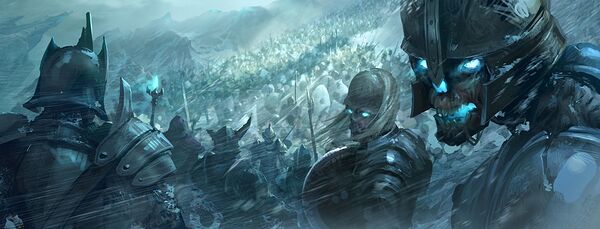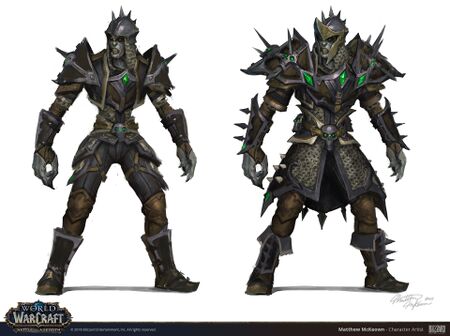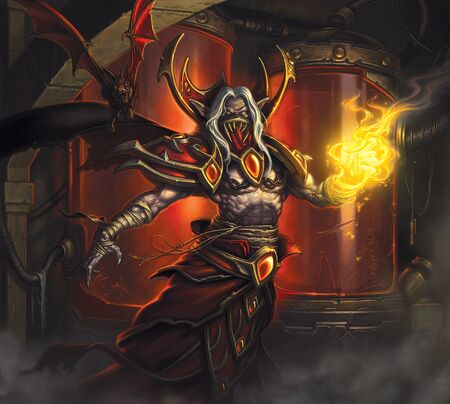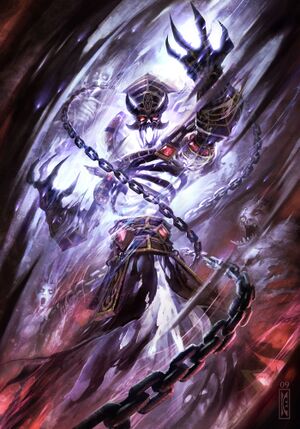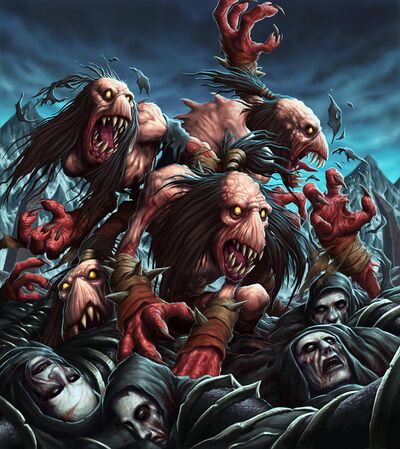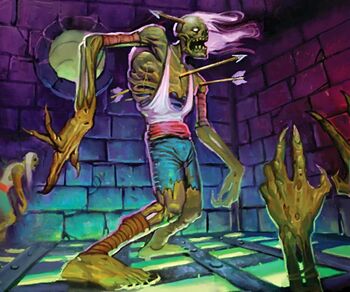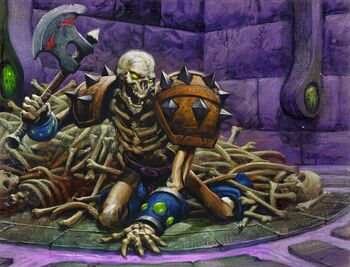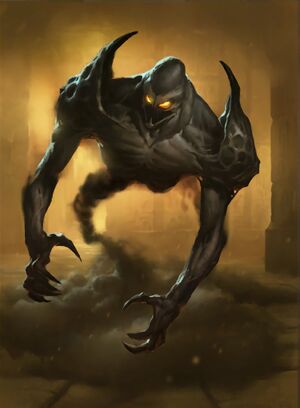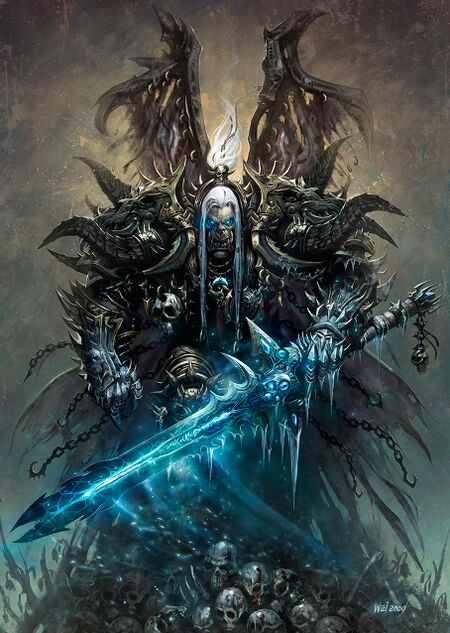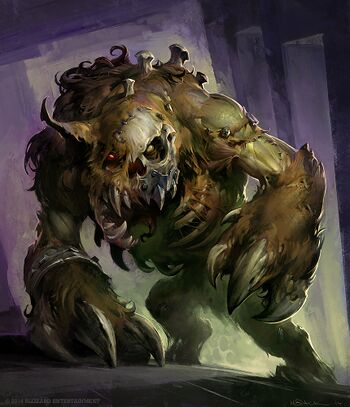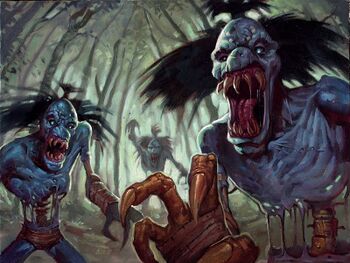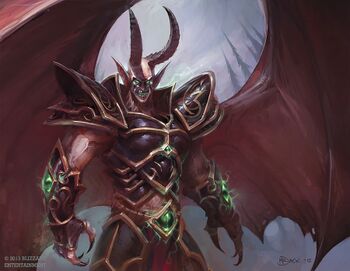User:GoldenYak/Chronicle/Shadol
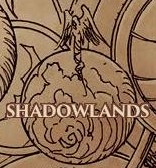 Shadol, Realm of the Dead | |
| Type | World |
| Races | Undead, primarily Forsaken |
| Languages | All |
| Location | The Shadowlands |
| Status | Bound to the seven Titan Worlds as an afterlife realm. |
- "As far away as the thickness of a shadow."
Shadol, also known as the Shadowlands. A world that exists beyond the Great Dark Beyond, beyond the material realm. The seven Titan Worlds are bound to Shadol in strange and unknowable ways, and lost souls from the Titan Worlds are drawn to Shadol, taking shape as undead beings in the dark and frightening lands found there.
Background
Shadol came into existence when the Titan Worlds were created. Its fullest origins are tied to the Shadowlands, a realm of spirit and decay once tied to Azeroth. When Azeroth awoke as a Titan and forged the Titan Worlds, a shadow of her past existence was left upon the fabric of the Shadowlands, and that shadow became the world of Shadol. Shadol is bound to the seven Titan Worlds through mystical conduits that serve to ferry souls of the dead from the Titan Worlds to Shadol. While not every soul that perishes is bound to travel to Shadol, the vast majority of the dead find themselves drawn there.
Early history
Shadol is a realm that lies even outside the ordinary flow of time. A moment can pass like a hundred years, and a hundred years can pass like an eternity. Little is known of its earliest ages, but legend speaks that it was once ruled by a king and a queen, who reigned over all who dwelled there.
Current Era
Scattered across Shadol are countless kingdoms ruled by the undead. The largest of these is the kingdom of Sylvania, ruled over ostensibly by a matriarch known as the Dark Lady. The true nature of this being is a great mystery, and her will is carried out by a dark aristocracy of powerful undead beings.
Geography
Shadol is a dark reflection of the world of Azeroth, in more than one sense. Its surface resembles of that world before its awakening as the Final Titan, but with its lands and seas reversed - where there was ocean on Azeroth, there is land on Shadol. And where the continents of Azeroth were, on Shadol are vast seas of blackness, a substance that is neither water nor shadow.
Shadol is a world that bristles with the cosmic power of Death and Decay. Vast quantities of necromantic energy permeate the world. Anything that dies on Shadol does not remain still and unmoving, but inevitably rises again.
Outposts and cities
- The Inevitable City - The largest settlement on Shadol, the Inevitable City is a vast, sprawling cityscape that stretches for miles and miles in all directions, far larger than any city ever built in the lands of the living. Its buildings are made of rotting wooden planks and corroded metal, seemingly perpetually on the verge of collapse, and yet somehow never fully deteriorating. Countless undead populate its streets, going about their gloomy business in an unliving parody of living cities. At its heart is the great Eternal Fortress, a colossal structure stretching impossibly high into the air, festooned with turrets and towers, utterly impregnable.
Inhabitants of Shadol - The Undead
Shadol is populated entirely by the undead. The most common form of intelligent undead are forsaken, while less numerous undead include vampyrs, liches, and ghouls. The various states of undeath are not truly races unto themselves but rather afflictions, and so the ranks of the undead include all the mortal races of the Titan worlds - thus forsaken can be former humans, dwarves, orcs, or any other mortal being. This holds true for all forms of undeath.
Non-intelligent undead also exist, typically in the form of shambling zombies or animated skeletons. Undead beasts and monsters also populate the world, born from the vast quantities of dark energy that exist on the world.
Living beings can survive in Shadol for a time, but there is nothing in the realm that will sustain the living in the long term. While there is flesh, vegetation, and water of a kind in Shadol, no substance native to the realm can truly nourish the living. Only the undead can draw strength and sustenance from the dark bounty of Shadol.
Forms of Undeath
Undead typically resemble the race of mortal they were in life, though inevitably twisted and deformed by their undead state. Below are some of the most common varieties of undead that can be found in Shadol, though the forms that undeath may take in the Realm of the Dead are almost without limit.
Forsaken
The most common variety of dead to inhabit Shadol and retain the same degree of sentience they possessed in life. Most forsaken retain their memories and personality from their former lives, though they are inevitable tainted by undeath and rendered morbid and cynical echoes of their living selves. Forsaken appear gaunt and withered, their bodies wasted as if a corpse had been left to molder for many months. Despite their seemingly deteriorated state, forsaken are nearly as strong as they were in life, and are often more physically durable as they care nothing for minor physical injuries and are almost immune to discomfort. The blood in their veins is a black sludge, their organs are shriveled and useless. Most of their biological functions no longer operate, but if a forsaken feeds on living flesh, they can digest and regenerate their damaged bodies. In mockery of living beings, forsaken do need to eat and drink, but the fare they subsist on replenishes the necromantic energy that sustains and animates their bodies, rather than nourishing their physical form. A forsaken that loses a limb can readily accept a graft if living blood and flesh are used to weld the limb to their undead frame. Forsaken do not need to sleep, and indeed those who attempt to do so are often plagued by horrific nightmares of torment and misery, or worse, memories of better times in the land of the living that are forever denied to them. Forsaken maintain their tenuous mental health by focusing on some greater cause, often serving a ruling lord or master of one of the undead kingdoms of Shadol. Forsaken that lose this occupying focus can be overcome by their own memories and dark emotions, which can trigger their deteriorating and transformation into lesser and more monstrous forms of the undead.
Vampyr
The curse of the Vampyr was born in some long lost era, formed from the demonic energy of the Nathrezim blended with necromantic energy. The curse was passed on to mortals as part of a Dreadlord experiment, and has remained a blight on the living races ever since. Vampyrs are undead who possess tremendous physical strength and often powerful sorcerous abilities inherited from the Nathrezim related to controlling the will of other beings. These abilities must be fueled with great quantities of the blood of living creatures, which is the only nourishment that can sustain a vampyr. While vampyr can feed on the blood of beasts, most are driven to drain the blood of other mortals, relishing the anguish and fear of their victims. Vampires in Shadol can feed on the black blood of forsaken and other undead, though they vastly prefer the blood of living mortals.
Whether mortal or undead, vampyrs are highly skilled at binding the wills of others to their own, forcing their victims into subservience. Vampyrs often form cadres of powerful minions to serve and protect them. Larger cabals of vampyrs exist throughout Shadol and even the Titan Worlds, working to spread their influence and increase their control so that they may indulge themselves without fear of reprisal. Vampyrs see themselves as the most superior form of undead existence, and ultimately seek to dominate both Shadol and the living realm.
The older a vampyr becomes, the more powerful they grow, and vampyrs of great age undergo a kind of dark metamorphosis that renders them closer in form to the Dreadlords who created their curse, resulting in vampyr elders with bat-like wings, cloven hooves, and curling horns.
Lich
A lich is an exceptionally rare and powerful form of undead being. In life they were knowledgeable and talented magic-users, masters of the arcane arts and seekers of mysteries and lore. So great was their hunger for power and forbidden knowledge they sought out ways to extend their lifespans, seeking to cheat death itself in their quest for greatness. Inevitably, death comes for all, and even the mightiest mage had to succumb to the end of their lifespan. Those who refused to accept their natural end drifted into the realm of death with hearts full of bitterness and resentment, eventually coming to dwell in Shadol. Their spite for their loss of life caused their flesh and blood to corrode, leaving them as skeletal beings. Due to their tremendous arcane power and indefatigable will, they were able to retain their sense of self and their vast store of mystical knowledge. Indeed, unbound by physical restraints of living bodies and saturated with the supernatural energies of Shadol, their magical powers became monstrously magnified. This form of arcane powered skeletal undead came to be known as lichdom. Some are powerful enough to bind their spirits to magical objects in the realm of the living, and in doing so project their physical form into the mortal world. Such liches become known as some of the most cruel and wicked beings in the Titan Worlds. Only the destruction of the object their soul is bound to, a relic known as a phylactery, can banish the lich back to Shadol. As long as a phylactery remains intact, liches can continually manifest their physical form anew in the realms of the living. This form of undeath is appealing to the most unscrupulous and unprincipled of magic-users, and some actually strive to attain this state even while they are still alive.
Ghoul
Ghouls are former forsaken who have been afflicted with a condition known throughout Shadol as 'ghoul fever.' A forsaken's undead body is in many ways more resilient than their living selves, but they can still be damaged, and they do not heal naturally as living beings do. Only when forsaken feed on living creatures can they regenerate the damaged done to their bodies - as their withered stomachs are filled with the meat and blood of the living, shriveled forsaken organs reawaken briefly, pumping fresh blood through atrophied veins to trigger the regenerative process. Some forsaken become addicted to the taste of blood in their mouths and the sensation of their bodies in a mocking parody of life, such feelings a welcome distraction from the drudgery of their undead existence. These forsaken are said to be afflicted with the ghoul fever, and will self-mutilate themselves before gorging on living flesh in order to experience the sensation of false life over and over. In time these bodily mutations, a regular diet of living flesh, and their unstable mental state serve to trigger a dark transformation, and the forsaken degenerates into a ghoul.
Ghouls are stooped, gangly parodies of their former selves, even more monstrous than their previous forsaken forms. Nearly all of their sentient thought has fled, leaving them near-mindless savages who desire only to feed on the flesh of the living. Ghouls can sustain themselves by feasting on undead flesh that is abundantly available in Shadol, but while this will prevent their bodies from decaying it will not truly satisfy their insane blood-hunger, and the longer a ghoul goes without feeding on the living, the more ravenously savage they will become. If a ghoul is well fed enough to keep the blood-hunger under control, they can became dangerously cunning, setting up elaborate traps and ambushes in efforts to secure more prey for later feedings. Many undead kingdoms keep a population of ghouls as slaves, deploying hungry ghouls as frighteningly effective shock troops. A pack of blood-starved ghouls can devour an entire legion of the undead, shredding rotted flesh and crunching up broken bone, only to be hungry for more, their ravenous hunger insatiable without fresh living meat in their guts.
Curiously, the savagery of the ghoul is rarely directed at others of similar affliction, and in fact ghouls are some of the most gregarious of undead. They prefer gathering in groups to dwelling alone, and ghoul packs will readily accept strangers and newcomers amongst their number, cooperating with one-another almost instinctively. A lone ghoul may take it upon themselves to lash together bones with scraps of leather hide to make a crude shelter; upon being approached by another ghoul, even a stranger, the two will almost immediately begin working together to make an even larger shelter to accommodate the both of them. Ghouls will fight each other only rarely, and in fact ghouls seem to suffer the effects of blood-hunger less often if they are with others of their kind. Wild ghouls congregate in large packs in the dark wildernesses of Shadol, working and hunting together. The reason for such monstrous camaraderie is a long-debated mystery among scholars of the undead.
Ghoul fever can sometimes manifest in the realm of the living, when desperate mortals resort to the most dire extremes to avoid starvation while in regions afflicted with high concentrations of dark magical energy. Cannibals who feast on the flesh of other mortals in the presence of such dark power find themselves twisted in the form of ghouls. Ghouls in the realm of the living cannot stand the natural light of day, and flee the sunlight to dwell in caves, crypts, abandoned settlements, and underground locations. The sites of great battles where the dead lie uncounted can draw ghouls from miles around, unnatural carrion predators who feast on the dead and nearly dead. If undead are discovered by mortals, hunting parties are often organized to exterminate them, and the slain degenerates awaken as ghouls in the wilds of Shadol, cursed to wear the form of a ghoul in death as well as in life.
Zombie
The forsaken of Shadol are grim and cheerless beings, mortal souls plunged into a world devoid of hope and light. Faced with a seemingly eternal damnation, a twilight existence of unending drudgery and gloom, many forsaken succumb to a malaise born of resentment and denial. They turn inwards, refusing to face their new existence, growing more and more withdrawn into their own minds while numbing themselves to the truth of their fate. In time, they extinguish their own thoughts and emotions entirely, their minds collapsing into a feral, sub-sentient state. No longer capable of maintaining their undead bodies properly, they began to decay and deteriorate, rot overtaking their flesh and organs. The necromantic power that animates them withers and curdles the last wisps of their soul, causing it to gutter into oblivion like a dying candle. Once the soul is extinguished and all sense of an individual self has fled, the forsaken has transformed permanently into a zombie.
As a rule zombies are mindless creatures barely animated by the barest wisps of necromantic energy. They are attracted by sound and movement and will instinctively attack anything mobile, whether undead or living, tearing at it with bony fingers and rotting teeth. The only things zombies will not attack are one-another. If a pack of zombies manages to bring down prey, the necromantic energy in their rotting bodies will instinctively absorb the energy of their victim, be it the life force of a living being of the necromantic magic of another undead. In this manner zombies may stave off further deterioration, but they can never truly heal or regenerate their damaged selves. Without a supply of preservative necromantic power, zombies will eventually fall apart entirely.
Other forms of zombification can occur when a soulless corpse, such as a deceased mortal being or even an animal, is imbued with necromantic energy, which serves to animate the dead remains as a zombie. Such zombies can be created by spell of necromancy, or may occur when living creatures perish in the presence of large amounts of necromantic energy. These zombies behave identically to the zombies of Shadol who were once forsaken - the only difference is in their origins.
Skeletal Undead
While becoming a zombie is the fate of a forsaken who succumbs to misery and retreats inwards mentally, forsaken can take on the form of skeletal undead if they allow themselves to be overcome with abject hatred and rage turned outwards upon everything around them. If a forsaken cannot accept their fate and are overwhelmed with loathing for the undead around them and their exile to Shadol, they descend into violent insanity and undergo a grisly transformation. The necromantic energy animating their bodies boils with their overwhelming hatred, causing their own flesh and organs to corrode and fall away, leaving behind nothing but bones. Even their tendons crumble to black dust, but the skeleton remains upright and mobile, their bones held together and animated by necromantic power.
While the mind of the undead is lost along with their brain, the soul of the undead endures, to an extent. Crippled by loathing, the soul remains bound to the bones of the skeleton, granting it a wicked and sinister nature that drives it to violently destroy any who approach, be they living or undead, in as gruesome and torturous a manner as they can manage. The only beings whom a skeletal undead will tolerate the presence of are other skeletal undead, the tainted necromantic energy of the skeletons resonating with one-another in a particular way that cause all skeletal undead to abide one-another. Powerful necromancers can use spells of binding to force skeletal undead into their service, but such creatures must not be underestimated or disregarded. Should they slip their mystic bindings, they will rend their erstwhile controller asunder with bony fingers, relishing the pain and suffering they cause.
Particularly hateful and malign souls that have become skeletal undead will sometimes continue to evolve over time, absorbing negative energy from the world around them and the misery and pain of their victims. The vengeful soul, bloated on wickedness, becomes visible amongst the bones they are bound to, appearing as wisps of pitch black smoke that seem to emanate from their skeleton. The smoke thickens and takes the form of black flesh, tendons and flayed muscles writhing and re-growing across the skeletal frame, making the undead appear as a lithe flayed corpse with rotting, necrotic flesh still clinging to its bones. Their wicked souls steadily regain the intellect and memories they once had in life, though the memories are always twisted and distorted into foul approximations of what truly occurred. Once sentient thought has been sparked anew, this marks the transition of the skeletal undead into a new state of unlife, a creature known as a ghast. Though their bodies still appear wasted and hideously skeletal, they are marked by the necrotic black flesh that has regrown across their bony frames, and the aura of tangible darkness that emanates from their nightmarish forms. Ghasts can become fiendishly intelligent, and have the ability to bind and control other lesser undead to their wills. They often develop dark ambitions to conquer and rule as warlords, leading small armies of the undead to ravage whatever lands they find themselves in. Entire petty kingdoms of the dead exist in Shadol with a ghast sitting upon their thrones.
Ghost
Forsaken who are overwhelmed by sorrow and misery at their dire fate can become consumed by their own emotions, causing their bodies to crumble into dust and leave them as disembodied specters. Known by a variety of terms, including spirit, geist, shade, banshee, and others, the most common name for undead in this state is ghost. Driven by their misery to torment those who still have physical form, they bear an especially spiteful hatred for the living.
Without a tangible physical form, ghosts exist purely as spectral beings, able to pass through solid matter as easily as a corporeal being might walk through open air. This does not mean they are incapable of interacting with the physical however - by focusing their anguish and loathing, ghosts are able to strike at a physical foe with terrifying force. Worse are ghosts who are capable of striking not at flesh but at the soul, reaching past a foe's weapon and armor and plunging their hands through flesh to grasp the spirit within. The touch of a ghost can plunge a being into abject terror and deepest despair, all while the spectral necromantic energy of the ghost devours their helpless victim's very life force.
A ghost that feeds upon sufficient life force can grow and swell in power, increasing in intellectual capability as well as expanding in their spectral power. Ghosts who devour the souls of those they slay can take on the memories and even the personality traits of their victims, becoming a gestalt consciousness composed of all those consumed. These bloated specters mutate and evolve into phantasmal demi-gods of death, capable of horrific supernatural carnage. Ghosts whose mind collapse utterly under such a transformation degenerate into unliving storms of chaos known as poltergeists, phantoms that exist only to ravage and destroy everything around them, mindlessly seeking to instill terror into others so they may devour it and grow stronger still.
Death and the Journey to Shadol
A mortal's lifespan is but a brief flicker compared to eternity, whether that being lives for a century or a thousand centuries. Inevitably, death comes for everything that lives. The mortals that dwell upon the Titan Worlds are no exception to this. Whether at the end of a long life well lived or brutally cut short in a tragic conflict, mortal souls shed their physical bodies, and the destiny for their afterlives begins. A mortal who has dedicated themselves to the preservation of the natural world might find themselves becoming a spirit in the wilds, protecting some enchanted grove far from civilization. A being who has aspired to find peace and fulfillment by becoming one with the Light of Creation will find their soul drawn into that great shining mystery, their dearest wish fulfilled. A foolish and wicked mortal who struck dark bargains with demons might find their soul bound for the realm of their demonic masters, a plaything to be rent and torn apart until they fall into a merciful oblivion.
But there are countless mortals who do not find rest at their life's end. Mortals who devoted themselves to no special cause, who lived distracted, blunted lives, those who were not especially wicked but neither good or righteous. Mortals who were lost and damned, who perished in anguish, their souls weighted down by anger, fear, or regrets. It is these souls, in their innumerable multitudes, that come to populate the majority of Shadol's dark lands.
When a mortal bound for Shadol perishes, their soul slides free of their bodies and tumbles into blackness. All around them is cold and empty, an empty place echoing only with their fears and regrets. After what seems like an eternity, hovering on the edge of consciousness, the soul finds themselves suddenly awake again, sheathed in flesh again - not alive, but with their physical body restored, bearing the scars of whatever wound may have ended their life. The newly fleshed soul has become undead, their unliving physical body preserved by dark energy - their blood is cold, their heart does not beat. And though they do not need to breath, they find themselves suddenly drowning, immersed in liquid blackness. Fighting to the surface, the undead breaks free from the black waters on the shore of one of the great dark oceans of Shadol - drenched in liquid black, they stagger onto a beach of cracked grey bone splinters. Their dark rebirth is complete - they are forsaken, an inhabitant of Shadol. From their point of transition, they will make their way into the lands of the dead, to whatever dark destiny they may find.
This is the fate of the vast majority of souls bound to Shadol, to become forsaken - the rank and file of the lost and the damned. Certain rare souls make the transition to Shadol in different ways, becoming different varieties of undead. Liches, for example, are mortal spellcasters who transform themselves into powerful unliving wraiths, their souls bound to a phylactery, a physical relic that exists in the realm of the living. A lich takes on physical form while in the land of the living, and if their material form is destroyed they appear on Shadol in a similar form, one composed of the dark matter of the realm of the dead. In time, a lich can manifest a new physical body for itself in the land of the living through their phylactery and thus depart Shadol. Mortals afflicted with the curse of the Vampyr will, upon their destruction in the mortal realm, appear in Shadol as vampyrs instead of forsaken.
Forsaken can also over time develop into different varieties of undead. Forsaken who succumb to hopelessness and despair may deteriorate entirely into mindless shambling zombies. If their hatred is especially powerful, it corrodes their flesh completely and they become animated skeletons, crueler and more vicious than lowly zombies. A forsaken mired in powerful sorrow does not slip into mindlessness, but the strength of their misery can utterly destroy their body, transforming them into phantasmal ghosts. A forsaken who abandons their living self and succumbs to animal bloodlust and hunger degenerates into a ghoul, a vicious and cunning breed of undead.
War Storms
While rebirth through the black seas is the most common way for dead souls to enter Shadol, the phenomenon known as War Storms is another way that frequently delivers lost souls to the Realm of the Dead. When terrible conflicts take place in the lands of the living, a chaotic storm manifests itself somewhere on Shadol. In the mortal realm, when warriors die en masse, towns are burnt, and fortresses crumble, the destruction is mirrored by dark rebirth within the War Storm on Shadol. Buildings that are burnt or flattered re-appear on Shadol, fortresses that are torn down erupt out of the black earth of the Realm of the Dead, and the masses of soldiers that perish in the conflict suddenly find themselves as undead amidst the dark reflection of the region they fought within. Oftentimes, these newly reborn undead do not understand that they have died and passed beyond the veil, and the conflict continues unabated. When a War Storm finally passes, a dark reflection of the ravaged region will be present on Shadol, the dead and the lost still embroiled in conflicts within the recreated land. These areas are often preyed upon almost immediately by the existing armies of Shadol, who enslave the newly resurrected undead and pillage the recreated towns and fortresses for material and treasure.
Kingdoms of Shadol
Sylvania, the Dark Kingdom
The largest nation on Shadol, whose capital is the impossibly vast metropolis known only as the Inevitable City. Sylvania controls the largest area of territory in Shadol, and is divided into seven smaller realms. The largest of the seven is the Inevitable City itself, ruled over by the Lord of the Wastes, the city regent who reigns in the name of the Dark Lady herself.
The other six regions are ruled over by the Deathlords, powerful undead beings who answer only to the Lord of the Wastes. Each Deathlord controls a vast army and is free to rule their territory as they see fit, provided they fulfill their duties to Sylvania by maintaining her sovereign borders against invaders, and contributing periodic tolls of troops, slaves, and goods to the Inevitable City. Above the Lord of the Wastes and the Deathlords is the Dark Lady herself, who never leaves her throne chamber within the Eternal Fortress at the heart of the Inevitable City. Her edicts are carried forth by the val'kyr, dark maidens who serve her directly.
Angrathar, the Wrathlands
- Deathlord: Lydisia Carmine, the Crimson Queen, the Bloody Val'kyr
The region known as Angrathar is one of the most hostile and dangerous in all of Shadol. Wracked by a colossal and seemingly permanent systems of War Storms known as the Wrathstorm, the realm is the site of never-ending battles as the newly slain dead emerge into their damnation en masse, often not realizing they have perished and continuing their combat unbated. Into this maelstrom of conflict strides Lydisia Carmine, the Crimson Queen, Vampyr-Deathlord of the Wrathlands. She was once one of the val'kyr, the angels of death who serve the Dark Lady herself. During a conflict with the blood-drinking vampires of Nothregoz and their slave-legions, Lydisia was swarmed by a pack of vampyric warriors who sank their fangs into the val'kyr's majestic form in an effort to force her into thralldom. Lysidia resisted the blood-magic of the vampyrs and turned their own power against them, blasting them apart and devouring their essence. However, the blood-curse of the vampyr took root in her own soul, transforming her into a vampyr. Her once glorious black wings melted from her body in torrents of blood and decaying feathers, forever setting her apart from her sisters. However, she retained her monstrous undead strength, increased ever further by her vampyric state, as well as all her deadly skill with a blade. What's more, her lust for battle has been sharpened to a near-berserker degree, an echo of her long-lost life as a battle maiden in some distant primal land, reawakened and amplified by the blood-thirst of the vampyr. In recognition of her former service and her new unique battle skills, she was declared a Deathlord and made mistress of the lands of Angrathar by the Lord of the Wastes.
Lydisia's mastery of blood-magic is unmatched, and her lust for carnage causes her to turn her powers towards martial means, forming the shed blood into razor-sharp blades to cut apart foes at a distance. Lydisia revels in the ecstasy of battle, using her immense crimson greatsword Bloodstorm to carve her victims apart in close-combat, while the shed blood of her foes sprouts into a forest of impaling spears or a tornado of crimson blades that hack and tear the enemy to pieces. Should a foe actually manage to wound Lydisia, she absorbs the abundant crimson bounty of the battlefield to fuel a terrifyingly rapid regeneration. Enemy forces have witnessed the Crimson Queen dismembered, decapitated, and ripped entirely to shreds, only for her to rise in a hurricane of blood, whole and healthy and laughing in delight at the shock in her foes eyes before tearing them apart with her crimson blades. At the height of her power, she forms torrents of blood into a pair of great feathered wings, allowing her to take to the skies as she once did in the past, a red angel shrieking and laughing with insane bloodthirst descending upon the foe to reap a crimson harvest.
Corp'rethar, the Horrorlands
- Deathlord: Attilar Angstrummen, Lord of Fear, the Uncreator
The monstrous Angstrummen is Deathlord of Corp'rethar, the Horrorlands. Angstrummen is a colossal brute of a man, a vrykul in life. Once a ruler of a great tribe, he was betrayed and cast out, his wives and children slaughtered in his absence, condemned by his traitor-kin to die in the wilds. He perished cursing all those who had wronged him, his bellowing soul falling into Shadol. Angstrummen's rage should have seen him dissolve his own body down to bones, becoming a mindless skeletal thing of hate and spite, but somehow his force of will spared him from this fate and he remained a vrykul forsaken. Instead, his fury radiates out from his dark soul like the heat of a furnace, scorching the flesh from the bones of all those who approach him and reducing them to near-mindless skeletal undead. Only those who keep their hearts free of fear are able to resist this terrible power of Angstrummen's.
Amassing a vast horde of subservient skeletal undead and renegade forsaken warriors, he rampaged across Shadol for years until he was defeated by the Lord of the Wastes during an attack upon Sylvania. The Lord of the Wastes was impressed with Angstrummen's power, and offered to spare him and grant him a boon if he would turn his powers to the service of Sylvania. Angstrummen asked only for the chance to avenge himself upon those who had betrayed him in life. The Lord of the Wastes invoked a dread ritual that tore open a rift between Shadol and the realm of the living, and Angstrummen led his horde of undead servants through to his old homelands. His former tribe was massacred, every living man, woman, and child butchered by the undead at Angstrummen's command. Angstrummen then raised the slain as his personal slaves and led them all back through the rift to Shadol, leaving not but ruin in his wake.
At his court in Corp'rethar, Angstrummen wiles away the centuries ripping the undead of his old tribe apart and twisting their broken bodies back together into hideous atrocities of flesh and bone, groaning abominations that spend every moment in anguish and terror. These great hulking horrors accompany Angstrummen and his legions into battle, sowing fear and terror amongst the enemy ranks, before Angstrummen himself scorches the foe down to their bare bones and enslaves them to swell his armies.
Mord'rethar, the Deadlands
- Deathlord: Heinrich Defilus, Harvester of Death, Lord of All Sorrows
Aldur'thar, the Desolate Lands
- Deathlord: Janos Nergal, the Tainted King, the Festering One
Umbra'thar, the Darklands
- Deathlord: Rava Terminastra, Archlich of Shadows
Dis'rethar, the Hungerlands
- Deathlord: Anton Gorrvinus, the Carrion King, Lord of Ghouls
The realm of Dis'rethar is lorded over by the bloated fiend known as Gorrvinus, the Carrion King. A human king in life, Anton Gorrvinus was never satisfied with the extent of his dominion. Despite his opulent palace and legions of obedient subjects, Gorrvinus always desired more, launching campaigns of aggression and expansion to expand his kingdom's borders, longing to become the emperor of his entire world and reign supreme over all lands. He gloried in the comforts of his station, becoming a bloated and indulgent fiend, but he possessed a keen intellect and shrewd mind, as well as surpassing tactical expertise. Despite his gluttonous self-indulgence in food, drink, and other base pleasures, he lived a long life by human standards before he finally perished. His ever-hungry soul, absent any nobility or redeeming qualities, plunged like a comet into Shadol - it wasn't long before Gorrvinus sough to continue his ambitions of rule and debauchery in the realm of the dead. His hunger sharpened and twisted by his undead state, he became afflicted with the condition known as ghoul fever. However, Gorrvinus' monstrously forceful personality allowed him to resist becoming simply another brainless ghoul, and he feasted on the flesh of his enemies to his black heart's content until his emaciated undead body had swollen into a bloated and corpulent state.
Impressing the Lord of the Wastes with his monstrous intellect, iron-hard will, and surpassing hunger, Gorrvinus was made a knight of Sylvania, and in time rose to become Deathlord over the realm of Dis'rethar. Gorrvinus exhibited a curious power born of his unique qualities - he possesses the ability to command the near-mindless ghouls of Shadol through force of will, forcing the ravenous wretches to answer his mental call and serve his will, subduing their normally uncontrollable hunger for flesh. While the other Deathlords look down upon Gorrvinus for employing such debased and loathed creatures in the armies of Sylvania, Gorrvinus cares not what others think of him, for his 'children' make devastatingly effect shock-troops. His fondness for ghouls has earned him such epithets as the Ghoul Lord and the Carrion King. Neither Gorrvinus' appetite nor his ambition have dulled even after centuries of service to Sylvania - in his hollow heart, he covets the throne of the Inevitable City for himself, and hungers to replace the Lord of the Wastes. To this end, Gorrvinus has turned his cruel intellect to ways of secretly increasing his personal power, and has begun to seek out the lord of the kingdom of Teron'Gar, a monstrous creature said to be capable of devouring souls as well as flesh. Gorrvinus longs to obtain this ability for himself, believing that feasting on souls will grant him the power to overthrow the Lord of the Wastes. And indeed, perhaps even the Dark Lady herself, one day...
The Lord of the Wastes
- "I have killed fathers with their sons. I have killed mothers with their daughters. I've killed great philosophers, proud young warriors, and revolutionaries. I've killed the evil, the good, the strong, the weak, the beautiful, and the debased. I have done this in the service of our Dark Lady, the Goddess of Death, and I have never once shown any mercy."
- — Lord of the Wastes
The ruler of the Inevitable City, to whom the Deathlords of Sylvania answer. The Lord of the Wastes rules the Inevitable City and indeed all of Sylvania in the name of the Dark Lady, who never leaves her throne chamber at the heart of her fortress. The Lord of the Wastes is called only by his title, or by the honorific 'Dread Lord'. His name in life is unknown, forgotten by even the Lord of the Wastes himself. The Dread Lord is garbed in black armor that he never removes, making his race difficult to determine, but the size and build of his body suggests that he was an orc in life.
The Dread Lord carries with him a mighty enchanted blade called Shadowmourne. The blade is a sorcerous weapon of malefic power, transforming in its master's grip into whatever form the Lord of the Wastes desires - a great two-handed sword, a mighty battleaxe, a wicked scythe. Whatever form it takes, it is a terrifying weapon with a haft of black metal and a blade of solid ice, known and feared throughout Shadol as a weapon that can devour one's very soul. The Lord of the Wastes' own soul is a vast and terrible black pit, drinking in the spirits of those he slays with his dread weapon, an all-devouring black maw that can never be sated.
The Dark Lady
At the heart of the Inevitable City is the great Eternal Fortress, and within this immense stronghold is the black throne chamber of the Dark Lady, the enigmatic demigoddess who reigns supreme over Sylvania and is feared throughout all of Shadol. Her origins are a mystery - none can remember a time when she did not reign in the Realm of the Dead. Some ancient legends whisper of a time that she did not reign alone, that once there was a king of the dead as well as a queen. Some even say that the king made the Dark Lady smile, once in a great while. If ever this was the case, it was an eternity ago, and for an eternity the Dark Lady has ruled alone. She never leaves her chamber, sending forth her val'kyr to carry out her will, permitting only the Lord of the Wastes to enter in audience with her.
The Dark Lady's power permeates the Eternal Fortress, devouring all light. The closer one comes to the throne chamber of the Dark Lady, the fainter light grows, and the deeper the shadows become. No matter what source of light is brought into the presence of the Dark Lady, whether mundane or magical, it will grow fainter until it goes out. Even those who can see in darkness through natural ability or spellcraft will find their sight fades until they are struck blind.
The most stalwart of mortals devoted to the radiance of the Light could only hope to shine their brilliance for an instant while within the Dark Lady's throne room. If such a mortal were to accomplish this feat, they would behold a vast, empty chamber, its floor made of cold metal, its walls impossibly distant and lost in utter blackness. They would see two colossal black metal thrones set opposite one another, one empty and frosted in ice, the other occupied by an entity shrouded in shadow. The mortal would behold only the barest impression of a tall figure, sheathed entirely in impenetrable blackness, a being towering over them as tall as a giant. And as the entity would rise and turn towards the mortal, they would see the suggestion of innumerable black feathered wings unfolding, and the hateful red glare of many eyes, before their radiance faded utterly and they were plunged into utter darkness forever.
Bleightergein, the Abominable Kingdom
A kingdom to the north of Sylvania, ruled over by a council of twisted forsaken devoted to unraveling the secrets of life and death through dark thaumaturgy, alchemy, engineering, and necromancy, a principle known as necrogen, or necromantic engineering. These twisted men and women of science have transformed their kingdom into an enormous laboratory, preying upon their subjects for use in their experiments. They have secured the loyalty of multitudes of desperate undead with the promise of eventually devising a means of creating new living bodies for souls to inhabit. The necrogeneers of Bleightergein have populated Shadol with countless abominations, twisted undead horrors made from stitched together limbs and organs, grafted with mechanical implements. The skies over Bleightergein crackle ceaseless with green lightning produced by their twisted efforts to perfect reanimation and resurrection.
Bleightergein is ostensibly an ally of Sylvania, providing the larger kingdom with support upon demand in exchange for a steady supply of experimental subjects and supplies. While in truth the rulers of Bleightergein would gladly see Sylvania destroyed, they would be crushed utterly by the larger nation in all-out conflict, and so must strive to keep their disdain for their mighty neighbor to themselves.
The Voodoolands
A kingdom that exists with an unliving jungle to the south of Sylvania. Ruled over by undead trolls and dark loa.
Teron'Gar, the Savage Kingdom
The kingdom of Teron'Gar is a brutal land even by the standards of Shadol. The inhabitants are little more than primitive savages animated by the vast and terrible reserves of hatred within the land's ruler, the legendary orc known as Teron Gorefiend. Many of them are ghouls, undead possessed of a vile hunger that drives them to feed on the flesh of both the living and the dead. Gorefiend and his savage hordes have threatened many other nations in Shadol, doing horrific damage in their raids and attacks. No force has ever been able to fully penetrate the lands defenses and strike at Gorefiend himself.
Thuzadia, the Realm of Forbidden Knowledge
A small realm hidden in the northern lands of Shadol, ruled by over the archlich Kel'Thuzad. Populated almost exclusively by mindless undead controlled by a ruling cabal of liches, led by the ancient archlich Kel'Thuzad. Although tiny by the standards of most kingdoms, the sorcery of its inhabitants make it almost inviolate.
Nothregoz, the Kingdom of Blood
A kingdom ruled by the demon Nosferath, one of the nathrezim, whispered to be the demon who created the dread curse of the vampyr. Nosferath and several of his fellow nathrezim reign over their kingdom with an iron hand, harvesting the dark power of Shadol to sustain themselves beyond the Twisting Nether. Nothregoz is dominated by a ruling caste of vampyr undead. Of all the kingdoms of Shadol, Nothregoz has the most living agents in the mortal realms carrying out the will of the Blood Kingdom's masters.
Visions of Shadol
Death Magic and the power of Necromancy
Beyond Shadol - The Dead Space
For all its strangeness, Shadol reflects the Titan Worlds in that it is a spherical planet like any world in the realm of the living. But Shadol orbits no sun, and overhead in its night skies shine lights that may be stars... or may be something else entirely.
Shadol is adrift in a great empty void, a seemingly infinite expanse of absolute nothingness known chiefly as the Dead Space. As Shadol reflects a living world, the Dead Space reflects the Great Dark Beyond of the material dimension. No one knows the nature of the far-off stars of Dead Space - given Shadol's lack of a sun, it may be that Dead Space has no such celestial bodies, and therefore the distant lights cannot be stars akin to the great fiery spheres of the natural world. Some speculate that they may represent other worlds like Shadol, worlds of death that act as afterlives for living worlds.
Few are the inhabitants of Shadol of a mind to contemplate the heavens, but certain elder liches in Thuzadia studied in the arcane have noted a curious, and perhaps worrying phenomenon - recently, a increasing number of these distant lights have begun to flicker and go out.
Beyond Shadol - Other Afterlives
While Shadol is the primary destination for the lost and the damned, not every mortal soul finds itself bound for its gray lands. There are other realms that the deceased find themselves drawn to, depending on their actions and devotions in life.
The Titan Worlds
Mortals who devote themselves to certain causes in the Titan Worlds may be granted an afterlife bound to the realm of the living. Apart from restless undead and phantoms that haunt a region, spirits of the dead who have no great regrets of unfinished business may still find themselves haunting a region of the living realm, not as unquiet phantoms but instead as guardian spirits. A mortal druid devoted to nature may find herself as the spirit-protector of the sacred grove she served in life. A loyal knight who protected a noble bloodline may become the guardian ghost of that family's hallowed crypts. defending their earthly remains from those who would defile them. Such devoted spirits may spend centuries or longer at their appointed task, though should their duty be undone by enemies, the oath-broken spirits may in their despair find themselves cast into Shadol.

